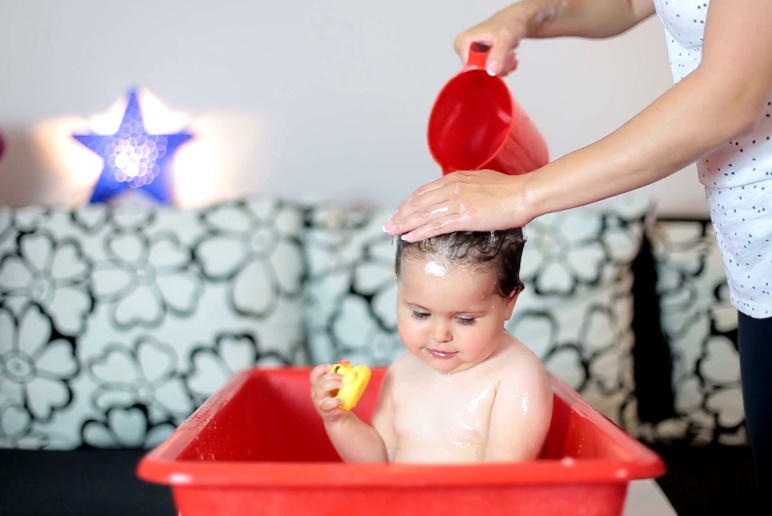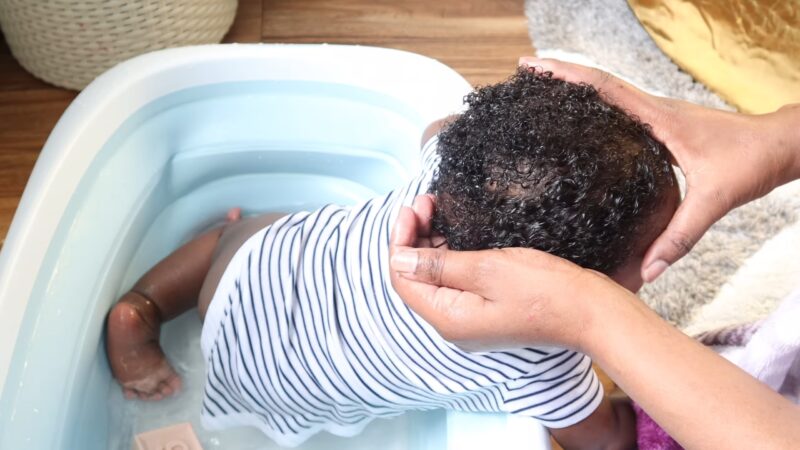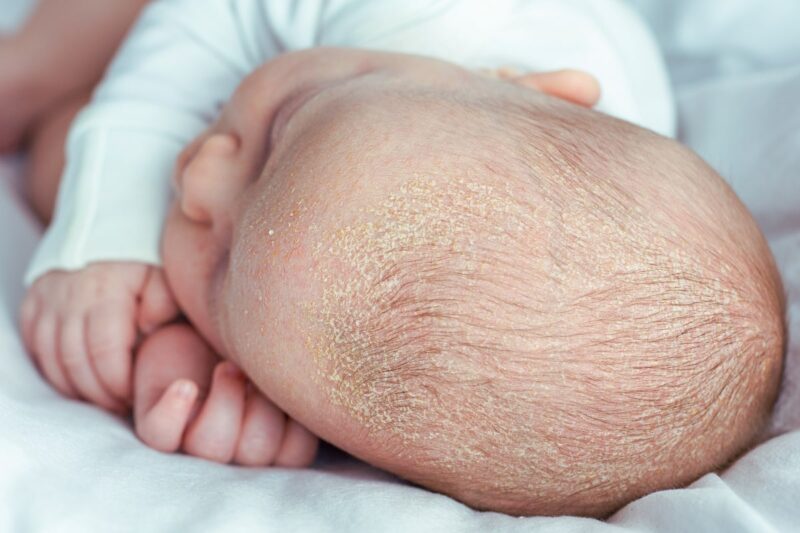Cradle cap, medically known as infantile seborrheic dermatitis, is a common skin condition that affects many infants during their first few months of life. It presents as yellowish, greasy scales or flakes on a baby’s scalp, resembling a scaly rash.
While cradle cap is not harmful or painful for the baby, it can be a cause of concern for parents. In this article, we will delve into the causes of cradle cap and explore natural remedies that can effectively address this condition.
Causes
Cradle cap is believed to result from an overproduction of oil (sebum) on the scalp, which can accumulate and cause dead skin cells to stick together. This leads to the characteristic appearance of flaky scales on the baby’s scalp. Several factors can contribute to the development of cradle cap:
- Maternal Hormones: During pregnancy, a baby receives maternal hormones through the placenta. These hormones can stimulate the baby’s oil glands, leading to an increase in sebum production. After birth, as the baby’s body adapts to its own hormonal balance, excess sebum production can continue for a while, contributing to cradle cap.
- Yeast Overgrowth: A type of yeast called Malassezia is commonly found on the skin. An overgrowth of this yeast can contribute to cradle cap. It is thought that the excess sebum production provides an ideal environment for Malassezia to thrive.
- Immature Oil Glands: In newborns, the oil glands on the scalp are still developing and can be prone to overactivity. This can lead to an accumulation of sebum and dead skin cells.
- Environmental Factors: Humidity and excessive sweating can exacerbate cradle cap. These factors can create a conducive environment for yeast growth and the accumulation of sebum and skin cells.
Natural Cures

While cradle cap can be persistent, there are several natural remedies that parents can consider to help manage and alleviate the condition. It’s important to note that every baby’s skin is different, so what works for one baby may not work for another. Before trying any new treatment, it’s advisable to consult with a pediatrician to ensure the best approach for your baby’s specific situation.
Gentle Scalp Massage and Brushing
Gentle scalp massage can help loosen the scales and improve blood circulation in the affected area. Before bath time, applying a small amount of natural oil, such as coconut oil or olive oil, to the scalp and gently massaging it can help soften the scales. After the massage, using a soft baby brush or a fine-toothed comb to gently brush the scalp can help remove the loosened scales.
Natural Oils
Applying natural oils to the affected area can help soften the scales and alleviate dryness. Coconut oil, olive oil, almond oil, and jojoba oil are all commonly used for this purpose. These oils have moisturizing properties that can help prevent the scales from becoming too thick and adherent. It’s important to avoid mineral oil and petroleum-based products, as they may not be as effective and can be absorbed by the baby’s skin.
Aloe Vera Gel

Aloe vera is known for its soothing and anti-inflammatory properties. Applying a small amount of pure aloe vera gel to the affected area can help reduce redness and irritation associated with cradle cap. Make sure to choose a high-quality, pure aloe vera gel without added chemicals or fragrances.
Breast Milk
Breast milk is rich in natural antibodies and nutrients that can be beneficial for a baby’s skin. Applying a few drops of breast milk to the affected area and gently massaging it in can help moisturize the scalp and promote healing. This remedy is especially convenient for breastfeeding mothers.
Oatmeal Bath
An oatmeal bath can provide relief for irritated skin, including cradle cap. Grind a small amount of plain, unflavored oatmeal into a fine powder and add it to the baby’s bathwater. The oatmeal will create a soothing and moisturizing bath that can help alleviate itching and redness.
Apple Cider Vinegar
Apple cider vinegar (ACV) has natural antibacterial and antifungal properties that can help combat the yeast overgrowth associated with cradle cap. Mix a teaspoon of ACV with a cup of water and apply the solution to the affected area using a cotton ball. Leave it on for a few minutes before gently rinsing it off.
Maintain Good Hygiene

Regular, gentle cleansing of the baby’s scalp can help prevent the buildup of oil, skin cells, and yeast. Using a mild, fragrance-free baby shampoo and warm water, gently cleanse the scalp a few times a week. Be sure to pat the area dry and avoid vigorous scrubbing.
Avoid Harsh Products
When choosing products for your baby’s skin, it’s important to opt for gentle, natural options. Avoid products with harsh chemicals, fragrances, and artificial additives, as they can exacerbate skin irritation.
FAQs
What is cradle cap, and why does it occur in babies?
Cradle cap, or infantile seborrheic dermatitis, is a common skin condition in infants characterized by yellowish, greasy scales or flakes on the scalp. It occurs due to factors such as maternal hormones passed to the baby during pregnancy, yeast overgrowth (Malassezia), and immature oil glands in newborns. These factors contribute to the excess production of oil and the accumulation of dead skin cells, leading to the characteristic appearance of cradle cap.
Is cradle cap painful or harmful for babies?
No, cradle cap is not painful or harmful for babies. While the appearance of the scales can be concerning for parents, the condition itself is not uncomfortable or painful for infants. It’s important to differentiate cradle cap from other skin conditions that might cause discomfort for the baby.
Are there any natural remedies for treating cradle cap?
Yes, there are several natural remedies that can help manage cradle cap. Some effective options include:
- Gentle scalp massage and brushing with a soft baby brush.
- Applying natural oils like coconut oil, olive oil, or almond oil to soften the scales.
- Using aloe vera gel for its soothing and anti-inflammatory properties.
- Applying a few drops of breast milk, which contains natural nutrients and antibodies.
- Trying an oatmeal bath to alleviate itching and redness.
- Using a diluted solution of apple cider vinegar to combat yeast overgrowth.
Can I use any type of oil for cradle cap treatment?
While natural oils like coconut oil, olive oil, and almond oil can be effective in softening the scales and moisturizing the scalp, it’s important to avoid mineral oil and petroleum-based products. These products might not be as effective and can be absorbed by the baby’s skin. Always opt for high-quality, pure oils without added chemicals or fragrances.
How often should I clean my baby’s scalp to manage cradle cap?
Gently cleansing your baby’s scalp a few times a week is sufficient to manage cradle cap. Use a mild, fragrance-free baby shampoo and warm water to cleanse the area. Avoid vigorous scrubbing, as it can further irritate the scalp.
When should I consult a pediatrician about my baby’s cradle cap?
If you’re uncertain about your baby’s skin condition or if the cradle cap seems severe, it’s advisable to consult a pediatrician. Additionally, if the cradle cap becomes red, inflamed, or begins to spread to other areas of the body, seeking medical advice is recommended. A pediatrician can provide guidance on the best course of action and ensure that there are no underlying issues causing the skin condition.
Conclusion
Cradle cap can be a temporary and harmless condition that affects many infants. Understanding the causes of cradle cap, such as hormonal factors, yeast overgrowth, and immature oil glands, can provide insights into effective management strategies. Natural remedies, such as gentle scalp massage, natural oils, aloe vera gel, breast milk, oatmeal baths, apple cider vinegar, and maintaining good hygiene, can help alleviate the symptoms and promote healthy skin for your baby.
As with any medical condition, consulting with a pediatrician before starting any new treatment is recommended to ensure the best care for your little one. Remember that every baby is unique, so finding the right combination of remedies may require some trial and error, but with patience and care, you can help your baby find relief from cradle cap.
